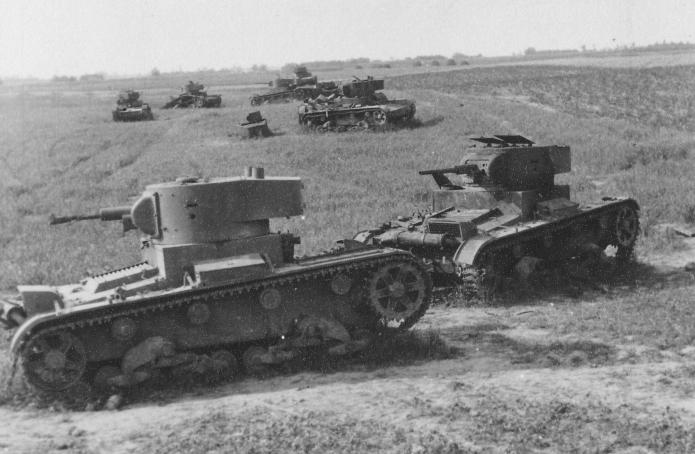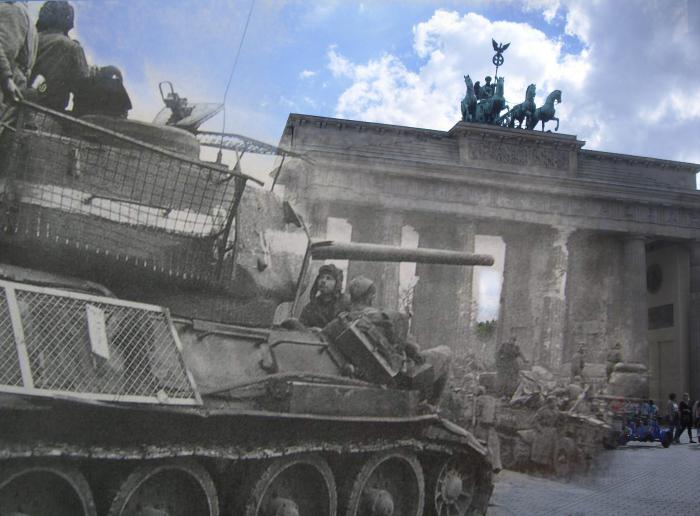
In the post-war decades Soviet cinematographycreated a lot of films about the events of the Great Patriotic War. Most of them somehow affected the theme of the tragedy of the summer of 1941. Episodes in which small groups of soldiers of the Red Army, armed with a single rifle for several people, resist formidable terrible masses (their role was played by plywood trimmed with T-54 or other modern machines), were encountered in films very often. Without questioning the valor of the Red Army soldiers who crushed the Hitler war machine, it is worthwhile to analyze some statistical data available to the modern reader interested in history. Suffice it to compare the staffing of the tank division of the Soviet Army and the Wehrmacht to make sure that the fascist military power of the cinema screen was somewhat exaggerated. With our qualitative superiority, there was a quantitative advantage, especially evident in the second half of the war.

The tank divisions of the Wehrmacht aspired to Moscow, theirthe famous panfilovtsy or unknown companies were kept, and sometimes the branches. Why did it happen that the country in which industrialization was carried out and possessed a cyclopic industrial and defense potential lost in the first six months of the war a significant part of its territory and millions of citizens taken prisoner, crippled and killed? Perhaps the Germans had some monstrous tanks? Or was the organizational structure of their mechanized military units superior to the Soviet one? This question worries our fellow citizens already three post-war generations. What did the German fascist armored division differ from ours?

Until June 1939, the Red Army had fourtank corps. After the Deputy People's Commissar of Defense E.A. Kulik headed the commission that checked the activity of the General Staff, the reorganization of the system of subordination of this kind of troops began. The reasons for the change of the corps structure can only be guessed, but the result was the creation of 42 tank brigades, which, respectively, had fewer units of equipment. Most likely, the goal of the reforms was the possible implementation of the renewed military doctrine, providing for deep penetrating strategic offensive operations. Nevertheless, by the end of the year, at the direct instruction of JV Stalin, this concept was revised. Instead of the brigades, not the former tank, but mechanized corps were formed. Six months later, in June 1940, their number reached nine. Each of the staff lists included 2 tank and 1 motorized division. The tank, in turn, consisted of regiments, motorized rifle, artillery and two directly tank ones. Thus, the mechanized corps became a formidable force. He possessed an armored fist (more than a thousand menacing machines) and a tremendous power of artillery and infantry support with all the necessary infrastructure that ensures the life of a giant mechanism.

Soviet tank division of the prewar periodhad in service 375 cars. The simple multiplication of this figure by 9 (the number of mechanized corps), and then by 2 (the number of divisions in the body) gives the result - 6750 armored vehicles. But that is not all. In the same year 1940, two separate divisions, also tank divisions, were formed. Then the events began to develop with uncontrollable swiftness. Exactly four months before the attack of Hitler's Germany, the General Staff of the Red Army decided to create another two dozen mechanized corps. This plan was not fully implemented by the Soviet command, but the process began. This is evidenced by the number 17 of the corps, which received in 1943 No. 4. The tank Kantemirovskaya division became the successor of the military glory of this large military unit immediately after the Victory.
29 mechanized corps in two divisions plustwo more separate. Total 61. In each of the staffing list 375 units, total 28 thousand 375 tanks. This is the plan. And in fact? Perhaps these figures are only for paper, and Stalin just dreamed of looking at them and smoking his famous pipe?
As of February 1941, the Red Army inThe composition of the nine mechanized corps had almost 14,690 tanks. In 1941, the Soviet defense industry produced 6,590 vehicles. The aggregate of these figures is, of course, less than that required for 29 corps (and this is 61 tank division) of 28 375 units, but the general trend indicates that the plan was generally fulfilled. The war began, and objectively not all tractor factories could withstand full-scale productivity. It took time to conduct a rapid evacuation, and the Leningrad "Kirovets" in general was in blockade. And still continued to work. Another tractor-tank giant, KhTZ, remained in the Nazi-occupied Kharkov.

Troops Panzerwaffen at the time of the invasion of the USSRhad tanks of 5639 pieces. Heavy among them was not, T-I, included in this number (there were 877), can be attributed, rather, to the wedges. Since Germany was waging war on other fronts, and Hitler was required to ensure the presence of his troops in Western Europe, against the Soviet Union, he sent not all his armored vehicles, but most of it, in the number of about 3,330 vehicles. In addition to the T-I mentioned, the Nazis had Czech tanks (772 units) with extremely low combat characteristics. All equipment before the war was transferred to the four tank groups created. This scheme of organization justified itself during the aggression in Europe, but in the USSR it turned out to be ineffective. Instead of groups, the Germans soon organized armies, each of which had 2-3 corps. The tank divisions of the Wehrmacht had in service in 1941 approximately 160 armored vehicles. It should be noted that before the attack on the USSR, their number was doubled, without an increase in the total park, which led to a reduction in the composition of each.
If in June-September 1941 the German unitsquickly moved deeper into Soviet territory, then by autumn the offensive had slowed down. The initial success, manifested in the encirclement of the protruding sections of the border, which began with the front on 22 June, the destruction and seizure of the vast stocks of material assets of the Red Army, the capture of a large number of soldiers and professional commanders, eventually began to exhaust its potential. By 1942, the number of machines had been brought to two hundred, but due to the large losses it could not be supported by every division. Wehrmacht tank armada lost more than it could receive as a replenishment. The regiments began to be renamed into pantsergrenaderskie (they were usually two), which to a greater extent reflected their composition. Infantry component began to prevail.

So, the German division (tank) in 1943consisted of two panzergrenadier regiments. It was assumed that in each battalion there should be five companies (4 infantry and 1 engineer), but in practice, four were used. By the summer the situation had worsened, the entire tank regiment that was in the division (one) consisted often of one tank battalion Pz Kpfw IV, although by that time the Panthers Pz Kpfw V appeared on the armament, which could already be classified as medium tanks. The new equipment hurriedly came to the front from Germany untethered, often out of order. This happened in the midst of preparations for Operation Citadel, that is, the famous Battle of Kursk. In 1944, the Germans on the Eastern Front of the tank armies was 4. The tank division as the main tactical unit had different quantitative technical content, from 149 to 200 cars. In the same year, tank armies actually ceased to be such, and they began to be transformed into ordinary ones.

The transformations and reorganizations that took placein Panzerwaffen, were forced. The material part suffered from combat losses, went out of order, and the industry of the Third Reich, which experienced a constant shortage of resources, did not manage to make up for the loss. Of the heavy vehicles of new types (ASF fighters "Yagdpanter", "Yagdtigr" "Ferdinand" and tanks "Royal Tiger") formed special battalions, they were not included in the tank divisions. Transformations practically did not undergo tank divisions SS, considered elite. There were seven of them:
Separate battalions and tank divisions SS Germanic General Staff used as special reserves, sent to the most dangerous sectors of the fronts in both the East and the West.

The war of the twentieth century was characterized bythe opposition of resource bases. Despite the impressive successes of the Wehrmacht in 1941-1942, German military specialists, three months after the attack on the USSR, understood in their majority that victory becomes impossible, and hopes for it are vain. Blitzkrieg in the USSR did not work. The industry, which experienced a large-scale evacuation, earned its full power, providing the front with a huge quantity of military equipment of excellent quality. The need to reduce the staffing of the Soviet Army was unnecessary.

Guards Tank Divisions (and otherspractically was not, this honorary title was assigned to all the outgoing combat units in advance) were completed since 1943 with the number of units of equipment. Many of them were formed on the basis of reserves. An example is the 32nd Red Banner Poltava Tank Division, created on the basis of the 1st Airborne Corps at the end of 1942 and received initially No. 9. It included, in addition to regular tank regiments, four more (three rifle, one artillery), and also anti-tank division, engineering battalion, communications company, reconnaissance and chemical protection.
